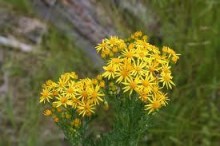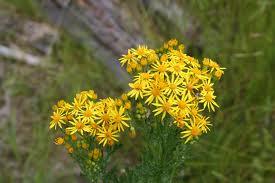— from Gwen Stamm —
REPRINT FROM AUGUST 25, 2013
Tansy ragwort is a winter annual, biennial, or short-lived perennial that can grow up to 6 feet tall. It is easily recognized by its bright yellow flower heads, with each flower bearing about 13 petals (ray florets), and by its soft, deeply lobed leaves. It is easy to spot when it is in bloom around this time of year.
Tansy is toxic to horses and cattle whether fresh or dry, causing irreversible liver damage. It spreads aggressively and seeds prolifically with seeds remaining viable in the soil for 10 years. Also, bees collect the pollen from tansy flowers. The honey that is made from these flowers can have an off taste. Milk collected from tansy-browsing-cows can also have an off taste.
Be sure to wear protective gloves and consider a face mask if you are sensitive to tansy ragwort’s allergens.
Small patches or isolated plants can be hand-pulled or dug with a shovel. Before bloom they can be discarded in the trash or left on the ground to decompose. However, if plant is in bloom, the flowers and seed heads need to be bagged and taken to the solid waste facility for no charge.
Mowing is not recommended as plants will just reflower at a height shorter than the mower blade. In addition, cut plants will re-sprout in the following season with even more vigorous and multiple stalks.
For large infestations, selective herbicides can be effective. Contact the County Noxious Weed Program for specific herbicide information. Phone number: 376-3499.
Article submitted by: Kate Yturri, Judy Winer and Gwen Stamm, recent graduates of the WSU Master Gardener’s Course.
**If you are reading theOrcasonian for free, thank your fellow islanders. If you would like to support theOrcasonian CLICK HERE to set your modestly-priced, voluntary subscription. Otherwise, no worries; we’re happy to share with you.**










Thanks folks…I suggest sending this message annually, perhaps a bit earlier in the season, as most of the tansy’s in our neighborhood have already gone to seed.
Please avoid using the herbicide Round Up which has been recommended in the past. This herbicide has been touted by its maker, Monsanto, as “safe as table salt” and environmentally friendly.
In fact, RoundUP is glyphosate-surfactant and has been linked by several studies by scientists around the world to causes damage to the liver and inhibits the liver’s ability to process toxic substances.
Monsanto’s own toxicologist, Rebecca Tominack, even participated in one such foreign study.(1)
Studies used for RoundUp’s initial US USDA registration have been called out as being fraudulent, yet no other studies have been undertaken by the USDA. Monsanto’s reach is obviously great and powerful.
New York State’s Attorney General sued Monsanto for claiming that RoundUp is “safe” and “environmentally friendly.” This suit ended in a $250,000 settlement with Monsanto agreeing to cease and desist from using these terms in advertising RoundUp in the state of New York. Monsanto violated the first settlement agreement and a second agreement was negotiated.
Ingestion of RoundUp has been shown to cause “irritation of the oral mucous membrane and gastrointestinal tract…pulmonary dysfunction, oliguria, metabolic acidosis, hypotension, leukocytosis and fever.”
A quick Google will turn up countless other research references that clearly demonstrate this products high toxicity.
There is really no room to “use just a little” RoundUP. I encourage everyone to please carefully read and research all chemical products you might entertain using – glyphosate-surfactants do not dissipate and enter the natural water systems and eventually enter the Salish Sea.